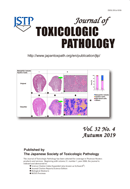Volume 32, Issue 4
Displaying 1-14 of 14 articles from this issue
- |<
- <
- 1
- >
- >|
Review
-
2019 Volume 32 Issue 4 Pages 213-221
Published: 2019
Released on J-STAGE: October 22, 2019
Advance online publication: July 27, 2019Download PDF (1021K)
Original Article
-
2019 Volume 32 Issue 4 Pages 223-232
Published: 2019
Released on J-STAGE: October 22, 2019
Advance online publication: July 05, 2019Download PDF (3110K) -
2019 Volume 32 Issue 4 Pages 233-243
Published: 2019
Released on J-STAGE: October 22, 2019
Advance online publication: August 15, 2019Download PDF (1429K) -
2019 Volume 32 Issue 4 Pages 245-251
Published: 2019
Released on J-STAGE: October 22, 2019
Advance online publication: July 07, 2019Download PDF (1148K) -
2019 Volume 32 Issue 4 Pages 253-260
Published: 2019
Released on J-STAGE: October 22, 2019
Advance online publication: August 10, 2019Download PDF (2245K) -
2019 Volume 32 Issue 4 Pages 261-274
Published: 2019
Released on J-STAGE: October 22, 2019
Advance online publication: July 28, 2019Download PDF (16338K) -
2019 Volume 32 Issue 4 Pages 275-282
Published: 2019
Released on J-STAGE: October 22, 2019
Advance online publication: August 20, 2019Download PDF (5094K)
Case Report
-
2019 Volume 32 Issue 4 Pages 283-287
Published: 2019
Released on J-STAGE: October 22, 2019
Advance online publication: June 06, 2019Download PDF (1757K) -
2019 Volume 32 Issue 4 Pages 289-292
Published: 2019
Released on J-STAGE: October 22, 2019
Advance online publication: June 09, 2019Download PDF (1916K) -
2019 Volume 32 Issue 4 Pages 293-296
Published: 2019
Released on J-STAGE: October 22, 2019
Advance online publication: June 22, 2019Download PDF (1315K)
Short Communication
-
2019 Volume 32 Issue 4 Pages 297-303
Published: 2019
Released on J-STAGE: October 22, 2019
Advance online publication: June 10, 2019Download PDF (2336K) -
2019 Volume 32 Issue 4 Pages 305-310
Published: 2019
Released on J-STAGE: October 22, 2019
Advance online publication: September 14, 2019Download PDF (2253K) -
2019 Volume 32 Issue 4 Pages 311-317
Published: 2019
Released on J-STAGE: October 22, 2019
Advance online publication: August 08, 2019Download PDF (2764K)
Technical Report
-
2019 Volume 32 Issue 4 Pages 319-327
Published: 2019
Released on J-STAGE: October 22, 2019
Advance online publication: August 11, 2019Download PDF (5251K)
- |<
- <
- 1
- >
- >|
